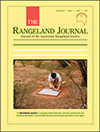For 22 months from mid-1958, a study of phyllode fall and nutrient content in an arid zone mulga community was used to identify rainfall or seasonal triggers. Less than a week after substantial rain, the rate of phyllode fall increased markedly regardless of season and nitrogen and phosphorus withdrawal from phyllodes increased. These previously unpublished results have renewed relevance for modelling carbon sequestration given the role of mulga communities in meeting emission reduction targets.

The Rangeland Journal
Volume 43 Number 1 2021
RJ20042The mechanism of species coexistence and diversity maintenance along aspects in the northeast of the Qinghai–Tibetan plateau
The alpine meadow ecosystem in Qinghai–Tibet plateau is sensitive to human activities and climate change. Community species coexistence and diversity maintenance are of great significance to ecosystem function. Based on the combination of phylogeny and functional traits, this study explored the driving factors of species coexistence and diversity maintenance, provided a theoretical basis for the protection of alpine meadow ecosystem structure and function, and provided a scientific basis for the management of the ecosystem and the protection and sustainable utilization of resources.
RJ20043Species replacement and transitional zones in natural grasslands with subtle environmental gradations
Ecological systems have limits where layout is essential to understanding system organisation at all scales. This study analysed internal heterogeneity in natural grassland estimating species replacement in space, and identifying transitional zones in the Flooding Pampa, Argentina. We found that species replacement did not fit linear or exponential models and that transitional sites showed extreme values in the environmental properties analysis. Knowledge about transitional zones is fundamental for the development of management strategies to prevent grassland degradation.
RJ20116A production-scale evaluation of nutritional monitoring and decision support software for free-ranging cattle in an arid environment
The ability to know future diet needs based on current environment and herd conditions would be an invaluable tool to cattle managers. This study was developed to test if a diet software combined with faecal data can predict future body condition in free grazing cattle, which was proved possible with localised and accurate information input into the software. This research can help managers in similar environments in utilising this technique to monitor free-grazing cattle herd performance.
RJ20028The role of the locoweed (Astragalus variabilis Bunge) in improving the soil properties of desert grasslands
Locoweeds cause persistent poisoning problems in desert grassland. However, they may be of ecological value in sandy, drought- and nutrient-deficient environments. Soil organic matter, available nutrients and microbial biomass were significantly higher in locoweed patches compared with bare patches, and these changes may be beneficial in improving soil quality in desert grasslands. A goal of locoweed control should not be total elimination because preserving the ecological services of locoweeds is also important.
RJ21018Is ground cover a useful indicator of grazing land condition?
 , Robert Shepherd, Robert A. Karfs, Brett N. Abbott, Teresa Eyre, Trevor J. Hall and Emily Barbi
, Robert Shepherd, Robert A. Karfs, Brett N. Abbott, Teresa Eyre, Trevor J. Hall and Emily Barbi
We tested the relationship between grazing land condition and remotely sensed ground indices at 2282 sites in Queensland, Australia. The relationship is significant but only moderately predictive. We discuss reasons for this and identify methods to better predict and map land condition using remotely sensed ground cover data.



